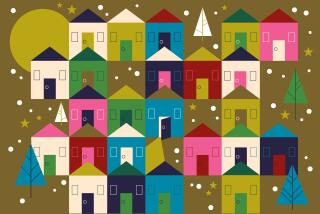Seeking inner quiet amid all the chaos
- Share via
During the holiday season, television and print ads have been hard at work whipping us into a frenzy. “Spend, spend, spend!” Whatever we might be desiring at this moment, we should buy now. Don’t we deserve it? Whatever junior has on his gift list, it’s our duty to purchase it; the child deserves the best. Buy! More! Bigger! Faster!
But can we buy what we truly wish for? Are our heart’s desires for sale?
Not according to Paula Huston, whose personal narrative, “The Holy Way,” suggests we take time out to consider the societal pressures surrounding us and make the conscious choice for a simpler, more spiritually connected life. “In a consumerist society like ours, people who wish to live simply must make a series of intentional choices against what is habitual, like the unrestrained use of credit cards, driving when walking is possible, and the unchallenged notion that faster or bigger or newer is always better,” she writes.
Why live simply? It may be better for the environment and make for a healthier, more enjoyable way to live, but for Huston the call to simplicity arises from a spiritual hunger that cannot be satisfied by what’s for sale at the mall: “I’ve had to anchor myself in a single, central reality -- my longing for God -- and allow everything else to arrange itself accordingly.”
Step by step, Huston takes readers with her as she explores age-old ways of living simply and consciously by following the practices of Catholic monasticism, including solitude, silence, fasting, manual labor, devotion, meditation and asceticism. These behaviors may seem archaic but can be instrumental in showing us how to pare back the busyness of 21st century life. Walking with Huston as she explores these disciplines provides a kind of blueprint for those who wish to live simply yet don’t know where or how to start.
Her own beginnings were not so long ago. A convert to Catholicism, Huston was introduced to down-to-earth living when she visited the monks of New Camaldoli Hermitage and was drawn to the effortlessness of their existence. “The white-cowled Camaldolese of Big Sur live in many ways as they lived a thousand years ago in Italy.... Their day is ordered around the ringing of the bells, the multiple calls to worship and prayer that take precedence over whatever work they might be doing.” This hermitage, Huston sensed, could be “the place I’d been looking for, the place that might teach me what I’d be trying so long to grasp on my own.”
Each of the 10 principal chapters examines a specific monastic discipline, with background on that discipline’s history, and is illustrated with a story from the life of a saint who exemplifies that discipline. The author’s experience applying these traditions in her contemporary life weaves in and out of the narrative, as when she writes of fasting as a spiritual practice. Midmorning of her first day fasting, she notices her body beginning to get “nervous.” “My body was like a Labrador retriever that had not been fed on time,” she tells us. Though her body knew she’d eventually feed it, “there was a touch of hysteria lying right beneath that thought.” With honesty and an open-armed embrace of her own fallibility, Huston pulls readers in, showing how odd and downright contrary it can feel to engage in a monastic discipline -- and yet how fulfilling.
Huston, as a newcomer to this way of life, illustrates well the experience of trying on specific spiritual practices for the first time but is unable to offer much firsthand information about the disciplines’ long-term benefits. She explores chastity, for instance, but the two incidents she describes (having to dress modestly when visiting countries in the Middle East and Asia so as not to violate local standards, and fighting the urge to concoct the perfect romantic fantasy) leave readers wondering how to practice this particular virtue in their own lives.
Maybe it’s her convert’s zeal, but at times her search for simplicity feels a bit frantic, as if she were determined to wrest spiritual satisfaction from her research and experiment in plain living. Learning to meditate, for example, she first buys a meditation cushion in an effort to feel more comfortable, and soon has her husband bring a crane to their property to take what had been the kids’ treehouse “from its moorings in a eucalyptus grove and [swing] it through the air to its new berth above the turtle pond” so she can have her own “little sanctuary.” This eagerness for peace sometimes obscures the simple existence she’s writing about.
It will be interesting to see where Huston goes with these disciplines over the next 10 or 20 years, when they’re no longer novelties but a way of everyday life. Still, “The Holy Way” is a good reminder, amid the chaotic demands of the modern world, of the reasons to simplify our lives and quiet our inner selves.
More to Read
The biggest entertainment stories
Get our big stories about Hollywood, film, television, music, arts, culture and more right in your inbox as soon as they publish.
You may occasionally receive promotional content from the Los Angeles Times.










